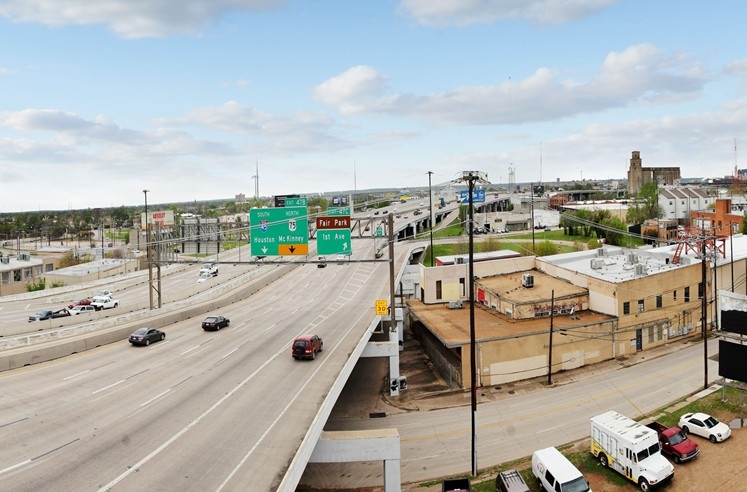
Late last week, a press release issued by the office of Senator Royce West announced that the state senator’s next “Eggs & Issues Town Hall Meeting” breakfast on March 21 will focus on transportation issues, specifically the oh-so-topical issue of the Trinity Toll Road and the need for congestion relief for those who travel on I-30, I-35E, and U.S. Highway 67. From the senator:
“For the past several months there has been discussion back and forth on the merits of local transportation projects, namely the Trinity Parkway and the Southern Gateway projects. I invite the public to share its opinions, be they in support or opposition to these particular projects,” said Senator Royce West. “It is one thing to object to a proposed project, but there is no denying that congestion is a daily fact of life for those who travel on I-30/the Mixmaster and on either I-35E/R. L. Thornton Freeway or U.S. Highway 67, particularly during morning and evening peak traffic periods.”
Senator West adds that the planning and study phases for these highway projects are part of the public record dating back at least 10 to 15 years. Since that time, problems with congestion have worsened drastically according to regional transportation officials.
Now, as anyone who has been stuck in rush hour traffic on U.S. 67, I-35, or the Mixmaster knows too well, driving those roads is not very pleasant during “peak hours.” Just yesterday I hit a virtual standstill just after 5:30 p.m. on I-35 south of U.S. 67 and jumped onto Kiest and used the relatively empty street grid to navigate north more efficiently. It was a small, anecdotal reminder of the underlying misconception at play in this conversation, that is, that building roads can solve road congestion. The reality is congestion relief begins with maximizing the potential of the existing street grid, while creating faster routes around town for traffic trying to move through the city.
Leaving aside this fundamental, underlying misunderstanding, what is irksome about this statement by Sen. West is the last line. West is under the impression that problems with congestion have worsened “drastically” during the 10 to 15 years. Or at least, that’s what he says regional transportation officials have told him. But this idea that congestion has worsened “drastically” is false, and not false in the usual Trinity Toll Road way where you have to squint a little and read between the lines to understand the duplicity. Here all you have to do is check the facts.
The facts are available, conveniently enough, via the TxDOT’s interactive Statewide Planning Map (h/t Patrick Kennedy). Click on that link, go to the map, zoom into the section you want to look at, and click AADT (Annual Average Daily Traffic) counts from 2007-2012. If you do that you’ll find that according to TxDOT, traffic counts along the corridors cited by Sen. West have not drastically increased in traffic. Rather, in most cases traffic on these roads has actually dropped or stayed relatively consistent.
I-35 North of I-35/U.S. 67 merge
2007 – 185,000
2008 – 190,000
2009 – 193,000
2010 – 191,000
2011 – 181,000
2012 – 178,000
I-35 South of I-35/U.S. 67 merge
2007 – 102,000
2008 – 93,000
2009 – 107,000
2010 – 109,000
2011 – 104,000
2012 – 104,000
U.S. 67 South of I-35 South of I-35/U.S. 67 merge
2007 – 98,000
2008 – 110,000
2009 – 99,000
2010 – 97,000
2011 – N/A
2012 – 89,000
The I-30 “Canyon” south of downtown
2007 – 179,000
2008 – 186,000
2009 – 184,000
2010 – 185,000
2011 – N/A
2012 – N/A, though the count at the I-30/I-35 interchange in 2012 was 155,000
Mixmaster
2007 – 227,000
2008 – 223,000
2009 – 215,000
2010 – 216,000
2011 – 237,000
2012 – N/A
The only real increase shown is in the Mixmaster, but even there the 2011 traffic count is not what I would describe as drastically larger than what traffic was in 2007.
It would be interesting to present these numbers to the senator and ask him about them during the breakfast town hall. The question should be asked in conjunction with one about the current improvements to the Mixmaster, the so-called “horseshoe project”, how it will further address congestion and why it is being constructed right now when the same 10 to 15 years of public record shows that transportation officials repeatedly said that work on that project couldn’t begin until after the Trinity Toll Road was built. Or, someone should ask why the public record is not allowed to reflect the projected traffic counts or toll estimates for the proposed Trinity Toll Road. Oh, and someone also has to ask the question Jim Schutze did this week, that is, when we find out how high the tolls will have to be to justify an unfunded $1.5 billion road that won’t actully do much to relieve congestion, who is going to be foolish enough to continue to pretend that this toll road project is somehow a civil rights issue? And then maybe someone could ask when our elective representatives will finally tire of being lied to by transportation officials and toss them out.
So many questions. So few breakfasts.





